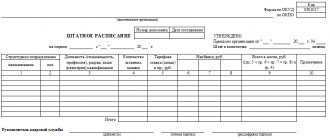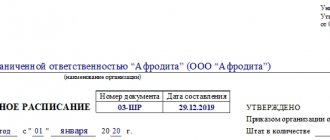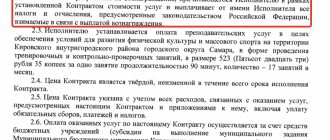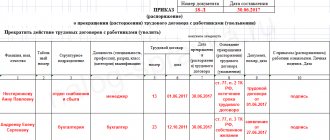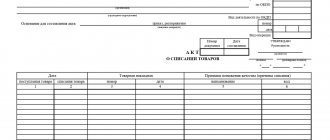Staffing: unified form T-3
From January 1, 2013, commercial organizations are not required to draw up personnel documents according to approved forms, that is, they can use independently developed document forms.
For more information about this, see the article “Primary document: requirements for the form and the consequences of its violation” .
However, the unified T-3 form is a fairly convenient and familiar way of designing the staffing arrangement. In addition, the staffing table of the T-3 sample form contains all the necessary information, so most employers continue to use this particular form of document.
Let us remind you that the staffing table - a form of the unified form T-3 - and the procedure for filling it out were approved by Decree of the State Statistics Committee of the Russian Federation dated January 5, 2004 No. 1. In order for users of our site to know how to draw up a staffing table, a sample document is presented in its pure form (in this section) and in the completed state (in the last section).
Sample of filling out the staffing arrangement
A standard arrangement is a type of working documentation created by the heads of organizations for the convenient conduct of activities. The content of the article
In the staffing table, information is generated on the occupied positions approved by the staffing table, including the surnames, first names and patronymics of employees, as well as their exact salaries.
It is also sometimes called full-time replacement. It contains detailed information on the personnel of the enterprise, along with high positions.
We recommend reading: Explanatory letter about the delay in delivery of goods
This document also has the following names: staff replacements and lists.
The law does not require mandatory accounting, which must be maintained by the human resources department. Staffing is a convenient way of personnel accounting. The head of the organization has the right not to create the document in question; he is not punished for this. According to regulations, there is no approved form of the staff list; therefore, it is developed by the organization itself.
When creating it, the T-3 form is usually used.
It is used when drawing up the staffing table, but only for the first document the presence of additional columns is provided. These columns record information about employees holding certain positions. These sections include last names, first names, patronymics, categories of employees that affect the amount of wages, the presence of a disabled group, information about leave and other information.
The category of workers is an important indicator when calculating wages; for example, it will be significantly different for a pensioner and a student. The characteristics listed above help in drawing up reports sent to the manager or maintaining statistics on significant topics.
This information may be needed by the Pension Fund of the Russian Federation, the military registration and enlistment office, insurance companies and other departments.
Regular replacement provides for the prompt transfer of data upon request by certain organizations.
But the main function of the document in question is the possibility
What information does the unified staffing form contain?
The staffing table is one of the internal regulatory documents that every organization (or entrepreneur with employees) must have.
What other personnel documents should the employer prepare, read the article “Personnel documents that must be in the organization.”
The staffing table contains:
- list of structural divisions;
- names of positions, specialties and professions indicating qualifications;
- information on the number of staff units;
- information on salaries: tariff rates and salaries, bonuses, wage fund (payroll), including for the organization as a whole.
The main purpose of the staffing table is to determine the structure, staffing levels and size of the payroll. The document does not contain the names of employees and their staffing positions. The staffing arrangement (synonyms: staff replacement, staff list) is not established by regulatory documents. Staff replacement, unlike the staffing table, is not a mandatory document for the organization, however, it is often used. This is due to the fact that full-time replacement allows you to track vacancies, as well as the filling of staff positions when hiring a part-time employee or if the position is divided between several employees. Staff replacement is usually developed on the basis of the staffing table of the T-3 form with the addition of a column in which the last names, first names, and patronymics of employees occupying certain positions are entered. If an organization uses staff replacement in its activities, then it must be taken into account that this document must be stored for 75 years.
ConsultantPlus experts explained in detail how the staffing arrangement is drawn up. Get trial demo access to the K+ system and go to the HR Guide for free.
Read about retention periods for personnel documents here.
What tasks does staffing help solve?
The main purpose of drawing up the document is to track vacant positions and determine the organization’s personnel needs. In addition, the use of staffing helps solve the following problems:
- track staff turnover;
- determine the availability of vacancies;
- establish the number of pensioners and disabled people in the state;
- analyze the salary range, etc.
In companies with a large number of employees and constant turnover, drawing up staffing will be especially relevant. If any position is vacated, an employee of the HR department, using this document, will be able to easily find a suitable candidate for the vacant position from among the existing employees.
How to properly draw up a staffing schedule
Drawing up the staffing table can be entrusted to any employee of the organization, and it must be approved by order (instruction) of the manager or other authorized person. If changes are needed to the staffing table, an order to amend the staffing table is issued. The procedure for issuing documents on approval of the staffing table must be enshrined in the constituent documents.
Read about the nuances of drawing up such orders in the material “Orders for core activities - what are these orders?”
When drawing up the staffing table for the first time, it is assigned the number 1, and subsequently continuous numbering is used. The staffing table indicates the date of preparation, as well as the date from which the staffing table comes into effect. These two dates may vary. Form T-3 provides an indication of the period of validity of the staffing table, details of the order for its approval and the number of staffing units.
Staff arrangement sample filling
Contents The staffing table contains information about the structure of the organization, its staffing and number, as well as wages for each position. However, personnel workers also use in their activities such a document as staffing.
Let's look at its features and differences from the staffing table in this article.
The document in question is also called a staff replacement and a staff list. It is not required to be maintained by the HR department, but rather is a convenient tool for maintaining personnel records.
The employer cannot be held liable for its absence. The legislator has not approved the form of this document, so the development and production of the staffing form falls on the organization itself. As a rule, the basis is taken form T-3, used to draw up the staffing table, to which another column (or several) is added.
It contains information about employees who occupy the corresponding position (last name, first name, patronymic, as well as the category of employee on which the employee’s salary or work schedule may depend, for example, pensioner, student, disabled person, etc.). This information allows you to create reports for management or maintain statistics on certain issues. Such information may be necessary to submit information to the Pension Fund, military registration and enlistment office, insurance companies, etc.
However, the main purpose of staffing is the ability to track vacant positions, determine the organization’s need for additional employees, and calculate the filling of staffing positions with existing personnel, including part-time workers. The preparation of this document will be very useful in organizations with constant “turnover” of personnel.
The staff list is an excellent tool for building an organization’s personnel policy.
If a position is vacated, the person dealing with personnel issues can, using this document, determine which of the current employees is capable of filling this position. Since the document under consideration is developed on the basis of the staffing table form, we present the procedure for compiling the staffing list along with the general provisions on the preparation of the staffing table. The staffing form (T-3) was approved by Resolution of the State Statistics Committee of Russia dated January 5, 2004 N 1.
Code of the structural unit in the staffing table and other information
The staffing table in the tabular section begins to be filled out by indicating the names and codes of structural divisions. As a rule, the department code in the staffing table is indicated in an order that allows one to determine the subordination and structure of the entire organization.
If an organization has branches and representative offices, then it must be taken into account that they are a structural unit of the organization, and accordingly, the staffing table should be drawn up for the organization as a whole. Even if the head of the branch has been given the right to independently approve the staffing table, it is still drawn up as part of a single staffing table. ConsultantPlus experts explained how the T-3 form is filled out in this case. You can get a free trial access to the system and study authoritative opinion.
Column 3 of the staffing table contains the name of the position, specialty, profession, which are indicated in the nominative case without abbreviations. The name of the position or profession is assigned by the employer, if the work is not associated with difficult working conditions and the provision of benefits, otherwise, when indicating the position in the staffing table, you need to be guided by:
- for the All-Russian Classifier of Worker Occupations, Employee Positions and Tariff Classes (OK 016-94) (approved by Resolution of the State Standard of Russia dated December 26, 1994 No. 367);
- All-Russian Classification of Occupations (OKZ) OK 010-2014 (MSKZ-08) (approved by order of Rosstandart dated December 12, 2014 No. 2020-st);
- Qualification reference book for positions of managers, specialists and other employees (approved by Resolution of the Ministry of Labor of Russia dated August 21, 1998 No. 7);
- unified tariff and qualification directories of works and professions of workers by industry;
- professional standards (paragraph 3, part 2, article 57, article 195.1 of the Labor Code of the Russian Federation).
How to bring job titles into line with professional standards, read here.
If an organization hires employees to perform a certain type of work, and not for a position (profession, specialty), then this also needs to be reflected in the staffing table.
Next, in column 4 of the staffing table, the number of staff units is indicated. Staffing units can be indicated as full or incomplete. The content of an incomplete staff unit in the staffing table is indicated in shares, for example 0.25; 0.5; 2.75, etc.
When drawing up the staffing table, special attention should be paid to column 5 “Tariff rate (salary), etc., rub.” In the simplest case, this column of the staffing table indicates a fixed monthly wage.
In practice, when drawing up a staffing table, the question often arises about the correct execution of the document in situations where there is no fixed amount of remuneration, for example, with piecework payment. In this case, it is recommended to put a dash in column 4 of the staffing table, and in column 10 indicate: “Piece-piece wages / Piece-piece bonus wages” and provide a link to the local regulatory act that defines the procedure for establishing wages, as well as its amount for a certain standard production. It is recommended to follow a similar procedure when filling out the staffing table in a situation where the employee has an hourly wage rate.
If the staffing table provides for an incomplete staffing position, then in the column “Tariff rate (salary)” the amount of the full salary for the position is still indicated.
Staff arrangement: sample filling
Download a document on the topic: Use a ready-made sample Staffing helps track vacant positions, determine the company's need for additional specialists, provides the opportunity to fill staffing positions with existing personnel in the organization, and hire new employees, including part-time employees.
This is important for organizations that have high employee turnover.
The staffing arrangement (in other words, staffing replacement or staffing list) contains the following types of information:
- List of other data.
- Full names of working employees.
- Terms of remuneration.
- Their personnel numbers.
- Which specific units are occupied in the staffing table.
The list of other data includes information about length of service, as well as other characteristics of working employees, for example, disabled, minor, working pensioner, part-time worker, and so on.
The staffing arrangement does not apply to documents that must be maintained in the personnel service.
However, in practice, such a document is used quite often, since, if necessary, it allows you to quickly navigate and restore the specific working conditions of all employees working in the company. Read in the magazine “Personnel Affairs”: Filling out the document is assigned to a personnel officer, or a responsible employee is appointed who will deal with this.
Standard arrangement: the sample does not have a unified form. The list is most often drawn up on a unified staffing form according to Form No. T-3, approved by the Resolution of the State Statistics Committee. In the table intended for filling out the staff list, the corresponding columns are filled in for each position.
The staffing arrangement may contain:
- names of departments or structural units to which the corresponding position belongs;
- the total amount of wages, which is calculated by adding the corresponding values from the columns directly related to wages.
- the total number of approved staff units for the position;
- information about the tariff rate (or salary);
- the amount of additional payments or allowances, if they are added to the tariff rate;
- name of a full-time position (or specialty, profession) with information about the level of qualifications (or rank, class, category);
- data of the employee who holds the relevant position;
How to fill out a staffing table: sample and example
A sample of filling out the staffing table of Form T-3 in a situation where there is no fixed salary, and there is also an incomplete staffing position, can be found on our website.
NOTE! In Art. 22 of the Labor Code of the Russian Federation states that payment should be equal for equal work. It follows from this that the “fork” of salaries in the staffing table is a violation of the Labor Code. Rostrud, in letter No. 1111-6-1 dated April 27, 2011, recommends that the same salary amounts be indicated in the staffing table for positions of the same name, and that the possibility of paying one of the employees wages (not salary) in a larger amount should be regulated through allowances and additional payments depending on the complexity work, quantity and quality of labor.
In columns 6, 7, 8 “Additional allowances, rub.” allowances are indicated - both accepted in the organization (for long working hours, increased responsibility, knowledge of foreign languages, work experience, etc.) and established at the legislative level (for example, for work in the Far North). The staffing table of the unified form assumes that these columns are filled in in rubles. If there are not enough columns to indicate all the allowances in force in the organization in the staffing table, then their number can be increased by issuing an order to supplement the staffing table form. It is recommended to do the same if the premiums are set as a percentage.
Column 9 “Total for the month” is filled out only if the salary and allowances are indicated in rubles. The instructions for drawing up the staffing table state that “if it is impossible for an organization to fill out columns 5–9 in ruble terms... the columns are filled in in the appropriate units of measurement (percentages, coefficients, etc.).” However, it is impossible to actually formalize the staffing schedule in this way. In such a situation, you can put dashes in this column, and in column 10 “Note” indicate a link to regulations, both internal and regulatory, that establish premiums. The link in column 10 to the document allowing you to set an increase for length of service will allow you not to change the schedule when the amount of the increase changes. Column 10 also indicates any information related to the staffing table.
In some situations, an employee may need an extract from the staffing table. A sample of filling out such an extract was prepared by ConsultantPlus experts. If you do not have access to the K+ system, get a trial demo access for free.
Terms and other features of storage of regular replacements
In the process of maintaining the staffing arrangement of the organization, the persons responsible for this have the right to adjust and modify the document in every possible way. The main thing is that this is done within the framework of its structure, and that it remains unchanged. Simply put, HR officers can remove fired employees from replacement, change their salaries and carry out similar actions, but when changing the tabular structure of a document, it is necessary to completely replace it.
Like any business documentation, staffing arrangements have their own shelf life. It is defined in the previously noted Order and is as much as 75 years. After this period of time, the document must be destroyed and, if necessary, replaced.
If, during the course of its activities, the enterprise carried out staff replacement, but later abandoned it, then you should not immediately get rid of the document. According to the law, the arrangement must be placed in the archive and kept there for the prescribed period. Naturally, no one will check compliance with such norms, but in order to implement legislative formalities, it is still not worth abandoning them.
The person who is reflected in it as such is directly responsible for storing the document. Often this is the head of the HR department, but if necessary, any representative of the HR department or the head of the organization can be entered in the appropriate column. At the legislative level, the powers and requirements for the person responsible for storing the replacement are not defined, therefore, in this regard, one should rely solely on the regulations of the enterprise itself.
This concludes the most important information on the summarized issue. As you can see, staff replacement is quite a multifunctional and useful document. Is it worth it or not? The question is complex. Perhaps representatives of any organization should answer it themselves. We hope the presented material was useful to all readers of our resource.
Top
Write your question in the form below
Nuances of registration and changes to the staffing table
The unified form T-3 requires the signatures of the head of the personnel service and the chief accountant, but it does not contain such requisites as a seal.
The frequency and timing of approval of the staffing table are not established by law, and each employer decides this issue independently.
Familiarization with the staffing table of employees is carried out only if this obligation of the employer is secured by a collective agreement, agreement, or local regulatory act (letter of Rostrud dated May 15, 2014 No. PG/4653-6-1).
Changes may be made to the staffing table if it is necessary to supplement it with new positions and structural divisions or, conversely, to exclude them, as well as when changing salaries, renaming departments and positions. Changes in the staffing table are formalized by order. There are 2 ways to make changes to the staffing table:
1) issuing an order on the corresponding change;
2) issuance of an order approving a new staffing table.
When reducing staff or numbers, or changing salaries, changes are also made to the staffing table, but it must be taken into account that the date of entry into force of the changes cannot occur earlier than 2 months after the issuance of the order. This is due to the fact that employees must be notified 2 months in advance about the upcoming layoff (Part 2 of Article 180 of the Labor Code of the Russian Federation) or about upcoming changes in the terms of employment contracts.
The staffing table is kept permanently in the organization. Organizations carrying out control and supervisory functions (for example, the labor inspectorate, regulatory bodies of the Federal Social Insurance Fund of the Russian Federation, the Pension Fund of the Russian Federation, tax authorities) have the right to request this document when conducting inspections. In case of failure to provide the documents or copies thereof requested by the controllers, including the staffing table, the employer may be subject to a fine of 200 rubles. for each document not submitted (clause 1 of Article 126 of the Tax Code of the Russian Federation).
What it is?
Among HR managers, the document is better known as personnel replacement. This is a list of existing positions in the company with an indication of the persons replacing them.
Such a local regulatory act conveys the overall personnel picture of the enterprise and is used for the convenience of the employer and HR.
Example of personnel replacement
What is the convenience:
- existing vacancies are clearly reflected;
- the distribution of employees across departments is visible, which simplifies the possible optimization of the number;
- allows you to process a large amount of data in organizations with a large number of employees.
The most important thing is that the absence of a mandatory form allows you to reflect the necessary data in the document, providing additional columns.
Results
The staffing table is a mandatory document that any employer must have. An example of filling out a staffing table using Form T-3 can be found on the Internet on many accounting and legal websites, but a sample with the situations described above is rarely provided. When preparing the staffing table, form T-3, a sample of which is given in this article, can be a good help for both experienced and novice personnel officers.
To learn how to properly organize personnel records, read the article “Personnel records management from scratch - step-by-step instructions.”
You can find more complete information on the topic in ConsultantPlus. Free trial access to the system for 2 days.
Full-time replacement: sample filling and important nuances of the procedure
> > > Work activities in the organization are filled with various kinds of bureaucratic nuances. The maintenance of some documents is mandatory and defined at the legislative level, while other documents can be entered by company representatives solely at their own discretion. One of the latter is considered to be a full-time replacement, used to create a list of employees of an organization and conveniently track it. We will talk in more detail about this document, the principles of its design and the features of this procedure today.
Also below you can find a sample for filling out a staff replacement, which can be easily used to maintain a list of employees of any Russian enterprise. Contents: Staff replacement or staffing arrangement is one of the many documents used in the personnel records system of an enterprise. At the legislative level, the need for its maintenance is not approved , however, many organizations still prefer to have this document in their possession and systematically use it in the process of their activities. This state of affairs is associated with a number of advantages received by any enterprise when carrying out staff replacement. In general, this document contains:
Personnel documents
- list of employees and their positions
The use of such lists allows the organization's personnel officers to always have an understanding of the personnel situation. Once having drawn up and timely corrected the document, representatives of the HR department can easily track employee turnover and respond competently to it. In addition, the information reflected in the arrangement is often required by government agencies, therefore, if there is a corresponding need and the document itself, the head of the enterprise will not need to unscheduled collect information about personnel composition.
In general, the legal background in the conduct of the staff
